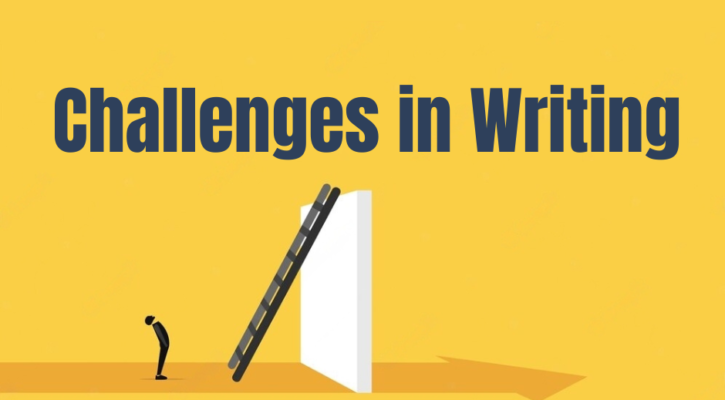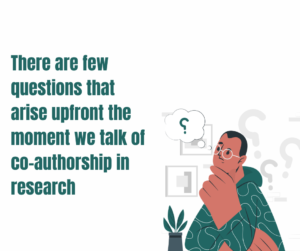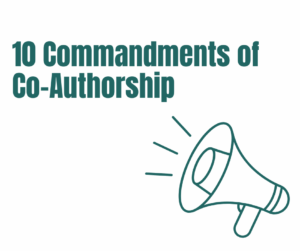Category: Research Paper

The Challenges in Writing a Multi Authored Academic Publication, More Co-authors for your research paper.
03/04/2023
Co authorship is when two or more authors collaborate to publish a research article. There has been a significant increase in multi disciplinary research which has also expanded multi authored academic research in the past few years. There are a variety of reasons for this growth, most commonly researchers attribute this growth to the incremented pressure of publication for career growth and promotions. With such a requirement, co authorship is often a lucrative return on investment. Another reason because of which collaborative writing
has increased are, better opportunities for co authorship as networks have increased and advances in technological developments have made it very convenient to work on the same text electronically.
Multiple authorship can be useful for the authors in various ways but it comes with its own set of challenges and conflicts. The various issues that can flare up in multi authored research need to be addressed so as to pre warn the authors to avert possibility of disputes.
There are few questions that arise upfront the moment we talk of co authorship in research.

Amongst the first few ones are:
a) What should be the order of names in the paper? The names should be listed on the criterion of contribution in the paper, seniority, alphabetically or any other logic should be applied to decide the first position in the names of the authors?
b) How to correctly justify the contribution of an academic colleague to grant him authorship credit. The question becomes more explicit. When we are talking in context of a PhD supervisor or research grant holder whose name sometimes is added merely by the virtue of their position.
These questions cannot be ignored as the credits of an author are a very crucial criterion for professional growth, getting funding and at the same time it is an important concern of publishing ethics.
Challenges associated with Co-Authorship
Paucity of appropriate training and guidance
Most of the researchers do not receive any training on co authorship and at the same time they also feel that the institution does not offer any special support for any kind of collaborative writing.
Confusion and Dissatisfaction:
Many researchers do not have enough clarity about this practice of co authorship and its resulting implications. Moreover, the increasing concept of co authorship has increased the intervention of senior professors and project guides in getting their names attached when a
paper comes to them for review. Senior academicians often get over credited and the junior ranked scholars and academicians do not get their dues for the amount of effort they put in. This leads to a general trend of dissatisfaction and confusion amongst the budding
researchers to emphasise towards co authorship.
Lack of Co authorship policies:
Institutions do not have co authorship policies and ethics placed in a structured manner which can help researchers to overcome the issues that overwhelm them in this regard. Institutions need to create a framework for co authorship policies and disseminate them amongst the
fraternity so that the best practices in the field are encouraged.
Acceptance of Diversity of work styles:
Not all researchers can have the same work style and when the author are three or more, clashes in work styles are imperative. It requires a whole lot of adjustment to get along with the working styles of other researchers. Most of the time this adjustment is accepted to be
from the end of the junior researchers where the senior professors and research guides don’t show any flexibility in their working styles with other budding researchers.
Miscommunication amongst the authors
The English saying, “ Too many cooks spoil the broth” applies pretty well in the concept of co-authored research tools. Clashes and miscommunication on the grounds of various factors is bound to create friction amongst the authors. All the details and approach should be
decided well in advance before starting to write the paper. This can surely minimise the complications that can arise because of miscommunication, but still there is always scope for friction in some form or the other Inappropriate writing tools or approaches:
Not all authors who choose to write under collaboration can have the same command over research tools or even gel into having the same approach towards writing. This can disrupt the uniformity of the paper in terms of the quality as well as the style for research. It not only affects the writing quality but many a times even frustrates the authors when they feel that the contribution of the other author is affecting the outcome of the research.
10 Commandments of Co-Authorship
A multi authored paper can be a outcome of a common discrete research project or even at times a much larger project that incorporates different papers based on common data or methods. It calls for a meticulous planning and collaboration amongst team members. The commandments of co authorship brought forth here can be applicable at the planning as well as the writing stage of the paper. The authors can come back to the rules from time to time for reiteration and it can surely build a foundation of a constructive research.
Commandment 1:
Contemplate well in choosing your co-authors The writing team is formulated at the formative stage of writing the paper. The pre requisite for choosing co-authors should be expertise and the interest area of research of the co- authors. This can be done by understanding the expectations of all the contributors in research and set up a research goal and also see that the researchers are up to working collectively towards the common goal. This step needs to be headed by the project leader who needs to identify the varied expertise required for making the paper. And also define the criterion that can be applied for qualifying as a co-author. There can be a situation of doubt in selecting co-authors sometimes and being inclusive in approach here does the trick. The roles
and responsibilities of the different authors can also be broadly defined at this stage.
Commandment 2:
Proactive Leadership strategy
A proactive leader is critical for a multi-authored paper so that the outcome is satisfactory in nature. The leader, who most of the time is the first author in the research paper should follow the approach of consensus building and not hierarchical approach while parallelly
working on the manuscript structure and keeping an overall vision of the paper alive.
Commandment 3:
An effective Data Management Plan(DMP)
A DMP that has been created and circulated at the initial level of the paper creation should have the approval of all co-authors. The DMP is a broad outline stating the way in which the data will be shared, versioned, stored and curated and the access to the data will be given to which all authors at different stages of the research project. The DMP should be a simple document but detailed and should be summarized in a couple ofparagraphs. All the data providers and co-authors should agree with the DMP confirming that it has the consensus of the institutional requirements as well as the funding agency.
Commandment 4:
Clearly define the authorship prerequisites and guidelines
Transparent authorship guidelines help to avert confusions and misunderstanding at all stages of the research. Depending on the amount of contribution by the author, the author order can be created with the person who contributed the most being right in the front. In situations where all authors have contributed equally alphabetical order can be used to create the order. At times some contributors might be there who do not meet the author expectations and predefined conditions. The alternative for them is to be included in the list of contributors in acknowledgement. The author order must be revisited and re considered during the process when the roles and responsibilities keep changing.
Commandment 5:
Give framework of writing strategy
He writing strategy that you decide for your co-authored article should be adopted according to the needs of the team. There can be one principle writer for the paper if the data is wide ranging in nature. The most commonly used strategy is when the paper is split into separate sub sections and the different authors are held responsible for sections based on their individual expertise and interest. Whatever may be the strategy it should. Be all inclusive of the co-authors, engaging them from the narrative stage to final structuring of the paper. Thiss urely helps in case the need arises to rewrite any part of the paper at any given later stage.
Commandment 6:
Choosing Appropriate Digital Tools
If you choose to do interactive writing for your paper, you may need aid of such platforms that support synchronous work as the whole group is writing together such as Google Docs On the contrary, those papers that are written sequentially or the principle author is doing the
writing task predominantly conventional platforms such as Ms Word may also work. At the preliminary stage itself , plan should be created for comments and tracking changes. In addition to the tool for writing, you will have to choose a platform for virtual meetings from time to time. You will need to compare the platforms on specific requirements you might have for your research meetings such as number of participants possible in a single group call, permission to record and save the meetings, screen casting or note making authority. With multiple options available in the present time for virtual interactions, customised options are there at a cost effective manner making it easier to choose.
Commandment 7:
Defining clear realistic and rigid timelines
Deadlines help to maintain the momentum of the group and facilitates on time completion of the paper. When you are a co-author, you must look at the deadlines se by the group leader from your on perspective and see that with all your other commitments will you be able to
live by them. Respect other authors time as well by being on time for meetings, schedules. By developing a culture of positivity and encouragement in the team keeping deadlines becomes easier and staying on task can be accomplished. Always remember that collaborative writing needs more revisions and reading sessions as compared to solo research papers.
Commandment 8:
Communicate effectively with all co-authors
Being transparent and explicit about expectations and deadlines helps to avert misunderstandings in the mind of the authors and helps to keep conflicts at bay. If you are the project leader make all consequences clear to the authors, like when they do not meet deadlines or if someone breaks the group rules. Consequences could vary from change in the authors order or removing authorship. If one co-author does not work well in the team, possible chances are he would not be included in the same team in the forthcoming research.
Commandment 9:
Collaborate with authors from diverse background and design participatory group model
When there are multiple authors in a research , chances are there that they may belong to different cultural or demographic backgrounds. It surely brings in a wider perspective to research and beings inputs from different backgrounds. There may be some language barriers
and they need to be overcome by a more empathetic approach towards the non-native speaker authors to allow them to express their opinions. A well curated participatory group model can be used to crate platforms for opportunity of expression for different personalities in
authorship.
Commandment 10:
Own the responsibility of co authorship
There are benefits in being a co-author and at the same time it comes with responsibilities. You have to owe responsibility of the paper as a whole and that you have checked the accuracy of the paper as a whole. One of the final steps begore submitting a co-authored paper are that all authors have given their consensus on their contribution and approval of the final outcome of the paper and also support its submission for publication finally.
Finally…
Despite a lot of challenges and obstacles in writing multi authored papers that have been discussed above, co-authored papers are the trend and they come with their own set of benefits that cannot be denied. There is no thumb rule in handling the challenges but the above commandments can be read and reread to customise according to the requirements of your team and its vision…If you still have never attempted a co-authored paper, the time is now. Go by the trend in research.
